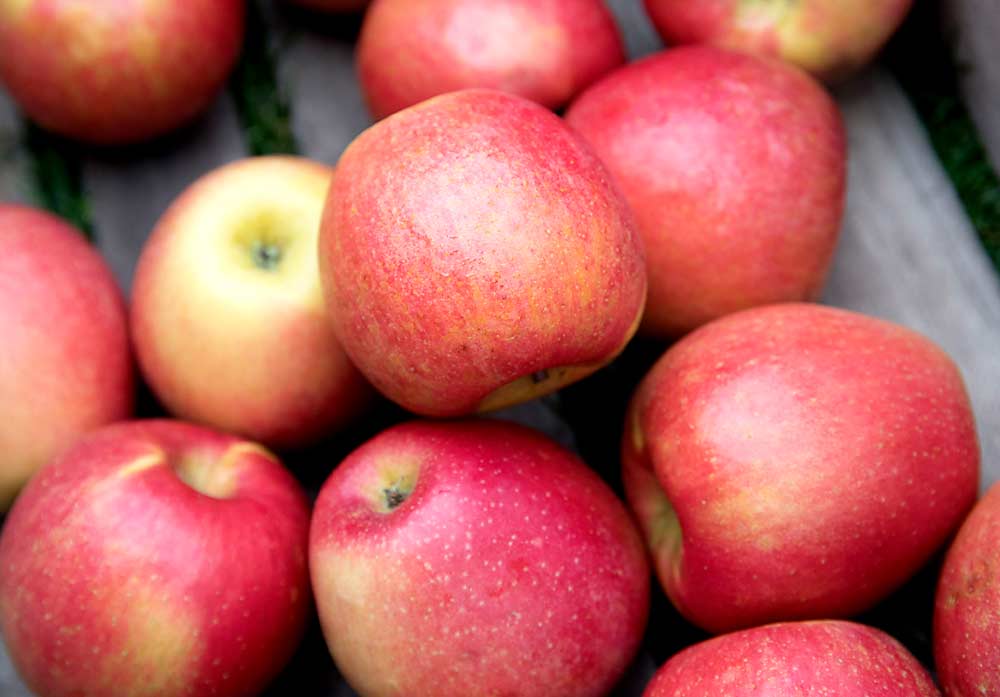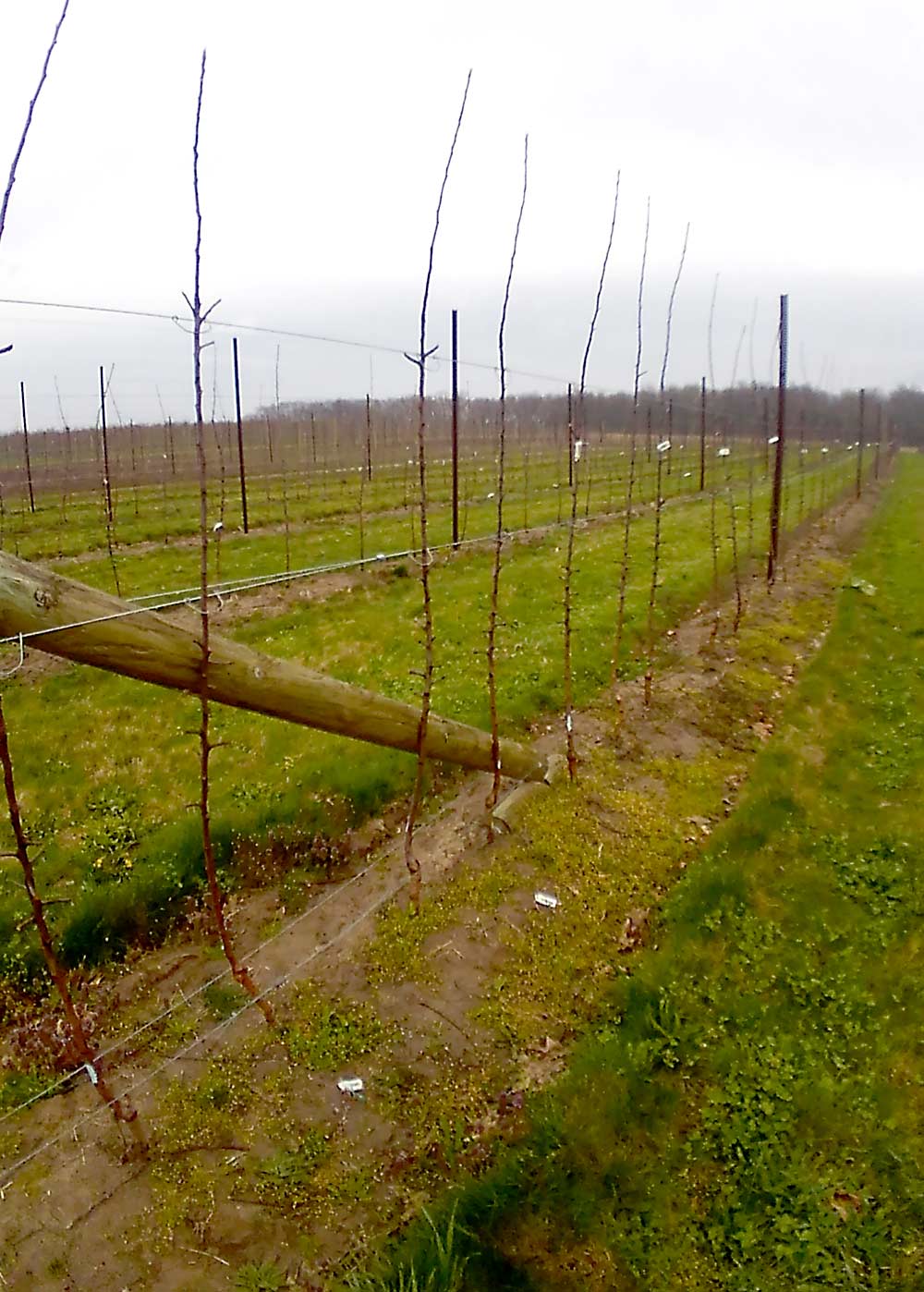
By any measure, EverCrisp has been a successful apple for the Midwest Apple Improvement Association. Since its official release several years ago, hundreds of thousands of EverCrisp trees have been planted in the Midwest and beyond, and it’s quickly turned into a top-selling variety for grower-members.
So, does the Ohio-based breeding group have another EverCrisp up its sleeve?
MAIA has released five varieties so far, with more on the way. Besides EverCrisp, the group’s first release, the variety getting the most attention from growers is MAIA-L, which is being marketed as Ludacrisp. Nurseries sold 55,000 trees for 2020, and 100,000 trees have been budded for 2021.
The largest plantings so far are in Ohio, where Ludacrisp originated, but the new plantings will expand the variety to other states. Many of the orders came from farm market and pick-your-own growers, said MAIA President Bill Dodd.
MAIA-L’s mother tree grew up in a test block at Lynd Fruit Farm in Pataskala, Ohio, on the outskirts of Columbus. Owner Mitch Lynd, a MAIA co-founder, said one of the open-pollinated variety’s parents is Sweet Sixteen, but the other parent is unknown.
The MAIA-L seedling caught the attention of Lynd and his collaborators early on. From its cuttings, they planted a few dozen trees on Budagovsky 9 rootstocks about seven years ago. It’s a grower-friendly, vigorous tree that does fairly well on Bud.9. The apple has a long picking window, and drop isn’t a problem, he said.
“I’ve always really, really liked the apple,” Lynd said.
It’s a big, pretty, scarlet red apple; its flesh is crispy; and it stores well. But the most striking thing about it is the flavor, which is unlike that of any other apple the Lynds have tasted. Mitch’s son, Andy, described it as “very fruity and juicy,” like tropical fruit. They started calling the apple “Juicy Fruit” around the farm, because it reminded them of the chewing gum.
The flavor was so unusual that Mitch Lynd took it to The Ohio State University’s Flavor Research and Education Center. “I said: ‘For the life of me, I cannot tell what I’m tasting here,’” he said.
The flavor lab found that the ester compounds that are the principal flavor drivers in MAIA-L are also the principal flavor drivers in pineapple, European red grapes and strawberries.
“When the principal flavor drivers of pineapple, grape and strawberry hit your tongue at the same time, it’s very fruity tasting,” Mitch Lynd said.
And those ester compounds survive fermentation, which is why hard cider made from Ludacrisp also can have a fruity flavor.
“I’ve spent lots of time trying to find apples that taste exceptionally good,” he said. “This apple repeatedly scores at the top of taste tests. The only apple that outscores Ludacrisp consistently is EverCrisp, but only slightly.”
Andy Lynd would have preferred to market MAIA-L as Juicy Fruit, but the trademark issues would not have been worth the trouble. After considering many options, MAIA’s governing board of growers chose the name “Ludacrisp.” Andy didn’t like the name at first, but once he saw the curious and amused reactions of customers, he changed his mind.
MAIA member Joe Burnham also didn’t like the name initially, but “it’s growing on me because it’s kind of a ridiculous name,” he said.

Lynd Fruit Farm planted 2,000 Ludacrisp trees last year, 2,000 this year, and plans to plant another 2,000 next year (on Geneva 41 and Geneva 11 rootstocks). They plan to sell most of the apples via pick-your-own. The trees are grown on a tall trellis system, so anything not reachable by the pick-your-own customers will be picked by farm employees and sold at the farm market. They expect to start selling large amounts next year, Andy Lynd said.
He said customers have had mixed reactions to Ludacrisp’s flavor so far.
“Either they really like it or it’s not their cup of tea, and there’s not a whole lot in between,” he said. “People that do like it can’t get that eating experience from any other variety.”
Burnham, who runs Burnham Orchards in Berlin Heights, Ohio, planted about 2,000 trees last year on G.41, and planned to plant 8,000 trees this year. His rationale for betting big on Ludacrisp wasn’t exactly scientific, but a marketer might understand. When he would come home from MAIA meetings with MAIA-L samples, his two daughters — who, despite growing up on an apple farm, don’t eat many apples — loved it. They kept asking about it afterward. That got his attention.
“I think it will sell well, once people try them,” Burnham said.
It’s still early, but Ludacrisp seems to be a grower-friendly tree, Andy Lynd said. It’s an annual cropper. The tree structure is nice, with lots of wide-angled branches.
Dodd, MAIA’s president, said Ludacrisp reaches the top wire quickly. Harvest is 10 days before Fuji.
To grow Ludacrisp, growers must be members of MAIA. The group’s requirements include signing a trademark license agreement, paying a $100-a-year membership, paying a royalty fee of $1 per tree at purchase, and paying trademark and logo fees of 20 cents per tree for years four through 10 and 30 cents per tree for years 11 through 20. For information on joining, visit www.maia.com. •
—by Matt Milkovich
Related:
—EverCrisp: A club for everyone
—EverCrisp release ramps up






Leave A Comment